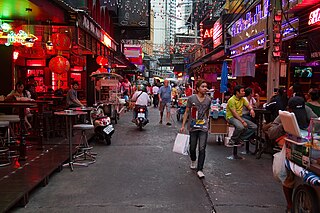It has been requested that the title of this article be changed to Prostitution in eSwatini . Please see the relevant discussion on the discussion page. Do not move the page until the discussion has reached consensus for the change and is closed. |
Prostitution in Swaziland is illegal, [1] the anti-prostitution laws dating back to 1889, [2] when Swaziland was a protectorate of South Africa. Law enforcement is inconsistent, particularly near industrial sites and military bases. [1] Police tend to turn a blind eye to prostitution in clubs. [3] There are periodic clamp-downs by the police. [4] [5]

Prostitution is the business or practice of engaging in sexual activity in exchange for payment. Prostitution is sometimes described as sexual services, commercial sex or, colloquially, hooking. It is sometimes referred to euphemistically as "the world's oldest profession" in the English-speaking world. A person who works in this field is called a prostitute, and is a type of sex worker.
A protectorate, in its inception adopted by modern international law, is a dependent territory that has been granted local autonomy and some independence while still retaining the suzerainty of a greater sovereign state. In exchange for this, the protectorate usually accepts specified obligations, which may vary greatly, depending on the real nature of their relationship. Therefore, a protectorate remains an autonomous part of a sovereign state. They are different from colonies as they have local rulers and people ruling over the territory and experience rare cases of immigration of settlers from the country it has suzerainty of. However, a state which remains under the protection of another state but still retains independence is known as a protected state and is different from protectorates.

South Africa, officially the Republic of South Africa (RSA), is the southernmost country in Africa. It is bounded to the south by 2,798 kilometres (1,739 mi) of coastline of Southern Africa stretching along the South Atlantic and Indian Oceans; to the north by the neighbouring countries of Namibia, Botswana, and Zimbabwe; and to the east and northeast by Mozambique and Eswatini (Swaziland); and it surrounds the enclaved country of Lesotho. South Africa is the largest country in Southern Africa and the 25th-largest country in the world by land area and, with over 57 million people, is the world's 24th-most populous nation. It is the southernmost country on the mainland of the Old World or the Eastern Hemisphere. About 80 percent of South Africans are of Bantu ancestry, divided among a variety of ethnic groups speaking different African languages, nine of which have official status. The remaining population consists of Africa's largest communities of Whites, Asian (Indian), and multiracial (Coloured) ancestry.
Contents
Senator Thuli Mswane [6] and NGOs Swaziland AIDS Support Organisation (SASO), Sex Worker Education and Advocacy Taskforce (SWEAT) and Mpumalanga Treatment Action Campaign (TAC) have recommended that prostitution be legalised in Swaziland, in order to allow it to be regulated to reduce harm to the prostitutes and limit the spread of HIV. [7]

The human immunodeficiency viruses (HIV) are two species of Lentivirus that causes HIV infection and over time acquired immunodeficiency syndrome (AIDS). AIDS is a condition in humans in which progressive failure of the immune system allows life-threatening opportunistic infections and cancers to thrive. Without treatment, average survival time after infection with HIV is estimated to be 9 to 11 years, depending on the HIV subtype. In most cases, HIV is a sexually transmitted infection and occurs by contact with or transfer of blood, pre-ejaculate, semen, and vaginal fluids. Research has shown that HIV is untransmissable through condomless sexual intercourse if the HIV-positive partner has a consistently undetectable viral load. Non-sexual transmission can occur from an infected mother to her infant during pregnancy, during childbirth by exposure to her blood or vaginal fluid, and through breast milk. Within these bodily fluids, HIV is present as both free virus particles and virus within infected immune cells.
Sex trafficking, [8] child prostitution [9] and HIV [10] are problems in the country.

Sex trafficking is human trafficking for the purpose of sexual exploitation, including sexual slavery. A victim is forced, in one of a variety of ways, into a situation of dependency on their trafficker(s) and then used by said trafficker(s) to give sexual services to customers. There are three types of activities defined as sex trafficking crimes: acquisition, transportation and exploitation; this includes child sex tourism (CST), domestic minor sex trafficking (DMST) or other kinds of commercial sexual exploitation of children, and prostitution. Sex trafficking is one of the biggest criminal businesses in the world.

Child prostitution is prostitution involving a child, and it is a form of commercial sexual exploitation of children. The term normally refers to prostitution of a minor, or person under the legal age of consent. In most jurisdictions, child prostitution is illegal as part of general prohibition on prostitution.



